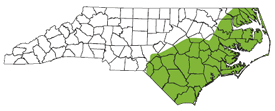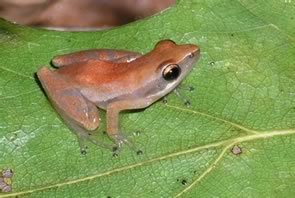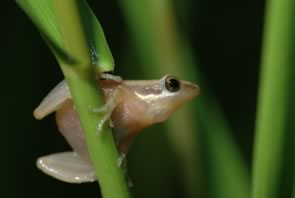
Pseudacris ocularis
Photo by JD Willson
Description: The little grass frog is the smallest frog in North America. It is relatively slender with long legs, small toe pads and a pointed head. The little grass frog can be tan, reddish, greenish or pinkish, and its pattern is often quite variable. A bold dark line passing through the eye onto the sides of the body is a definitive characteristic.
Habitats and Habits: These frogs inhabit moist, grassy environments, especially near temporary ponds and other wetlands in the Coastal Plain. Eggs are laid singly on the pond bottom or on vegetation in shallow water. The tadpoles complete metamorphosis six to 10 weeks after hatching.
Call: The breeding season for little grass frogs is long — from January to September, although their high-pitched, insect-like, tinkling call can be heard throughout the year. Some people are unable to hear the call due to its high pitch.
Frog Fact: Despite their small size, little grass frogs can jump about 20 times their body length.

The shaded region represents the range of the little grass frog in North Carolina.


.jpg)
Photo by Tom Luhring
Photo by Roger Rittmaster

.jpg)
Photo by Tom Luhring
This website created by: Grant Connette and Evan Eskew.
For comments or questions contact M. Dorcas: midorcas@davidson.edu.
M. Dorcas homepage: http://bio.davidson.edu/dorcas
Davidson College, Davidson, North Carolina 28035-1719.
Text and maps from: Dorcas, M. E., S. J. Price, J. C Beane, and S. S. Cross. 2007. The Frogs and Toads of North Carolina. North Carolina Wildlife Resources Commission, Raleigh, NC. – Copyright by Michael E. Dorcas
Partial Funding for this website provided by a Associate Colleges of the South, National Science Foundation, and Duke Energy.
